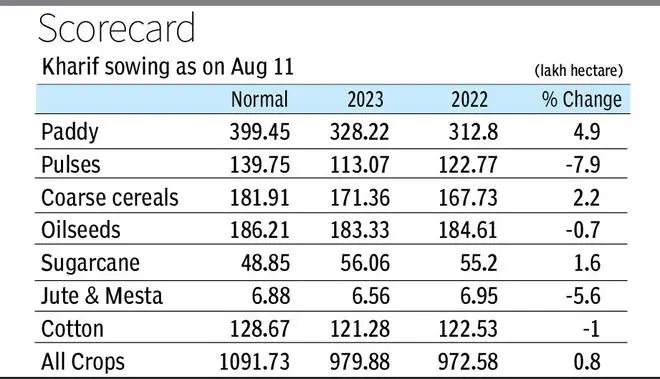Amid concern over a possible drop in rice production that led to a ban on the export of non-basmati white rice, sowing in paddy continues to be higher than in the year-ago period. This could potentially help the country in the production of rice being higher and remove the ban. The area under paddy has been completed in over 80 per cent of the normal area. It is 5 per cent more than the acreage in the year-ago period.
The overall acreage of all kharif crops has reached about 90 per cent of the normal area of 1,091.73 lakh hectares (lh). It is higher by 1 per cent from a year ago. If the monsoon renews its course after the current break phase in most regions of the country, excluding the east and north-east, as projected for August 17, officials anticipate the possibility of another bounty harvest year. The potential remains even if August concludes with below-normal rainfall.
In the last kharif season, foodgrain production was 155.12 million tonne (mt), a notch below the record 155.36 mt in 2021-22 mainly due to below-normal rain in east Uttar Pradesh, Bihar and Jharkhand. This season, the government has fixed a target of 158.06 mt, including 111 mt of rice.
“If everything goes normal from now, there will be definitely higher rice production this season and the government may have to consider easing export ban on raw and broken rice in October once the crop starts arriving on mandis. But, such a decision will also depend on rice prices,” said an official source.
The area under all kharif crops has reached 979.88 lh as of Friday — up from 972.58 lh a year ago, according to the weekly update released by the Agriculture Ministry. Paddy acreage has reached 328.22 lh against 312.80 lh a year ago. While cotton, groundnut and pulses have reported lower acreage, the area under all other crops has improved.
Shift from pulses
The area under arhar, moong and urad is lower this year due to a shift towards Shree Anna (nutri cereals) in many States after the monsoon was stalled for many days in June and high rainfall received in Rajasthan and Gujarat due to cyclone Biparjoy. Pulses production in the current kharif season may miss the target of 9.09 mt and sensing this possibility, the government has already allowed duty-free import of certain pulses.
The total area under pulses declined eight per cent to 113.07 lh from 122.77 lh. Moong (green gram) was covered on 30.03 lh (-7.3 per cent), urad in 29.55 lh (-13.5 per cent) and arhar in 40.27 lh (-5.4 per cent). Officials said that there has been a significant improvent in area under arhar in the past one month.

Oilseeds acreage declined 1 per cent at 183.33 lh (184.61 lh) and soyabean acreage was at 123.65 lh — up from 122.47 lh in the previous year. Groundnut area continues to slide from last year and reached at 42.10 lh (43.24 lh). Sesamum (til) acreage reached 11.29 lh, down from 11.95 lh, but castor area was higher at 5.34 lh from 4.71 lh.
The cotton acreage was reported at 121.28 lh, down from 122.53 lh. Jute and mesta, too, dropped to 6.56 lh from 6.95 lh. But sugarcane area was higher at 56.06 lh (55.20 lh).
Millets gain
The area under coarse cereals and Shree Anna have increased 2.2 per cent to 171.36 lh from 167.73 lh mainly due to higher planting under ragi, bajra and maize. Area under bajra has gone up by 1.2 per cent to 68.81 lh from 68.03 lh, ragi up by 33.5 per cent to 5.91 lh from 4.43 lh, and that of maize by 2.2 per cent to 79.17 lh from 77.47 lh. But, jowar area has declined 5.6 per cent to 13.29 lh from 14.08 lh.







Comments
Comments have to be in English, and in full sentences. They cannot be abusive or personal. Please abide by our community guidelines for posting your comments.
We have migrated to a new commenting platform. If you are already a registered user of TheHindu Businessline and logged in, you may continue to engage with our articles. If you do not have an account please register and login to post comments. Users can access their older comments by logging into their accounts on Vuukle.